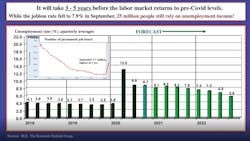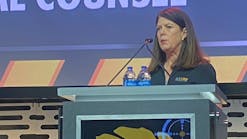At the Hand Tools Institute’s Fall Meeting this year, Bernard Baumohl, Chief Global Economist for the Economic Outlook Group, gave a presentation titled “The Economic Outlook in a Post-COVID World” where he discussed four major points that will determine the economic outlook for 2020-2022.
1. The path of COVID-19
Baumohl laid out three scenarios for how COVID could play out.
- A vaccine becomes widely available in the first half of 2021, but with no pandemic stimulus package the probability of recession is about 50 percent.
- A vaccine won’t become available until late 2021 or early 2022. This would cause an increase in business failures, meaning more workers on furlough or permanently out of jobs. In this scenario, with no pandemic stimulus package the probability of recession rises to 90 percent.
- There is the potential COVID may never fully go away. Other viruses in the coronavirus family such as SARS and MERS do not have an approved vaccine in the U.S.
Of these three scenarios, Baumohl and his fellow economists see scenario one as the most likely.
2. The pandemic stimulus package
It is unlikely a pandemic stimulus package will be passed before the election, but it is expected there will be a larger spending plan passed in Q1 of 2021.
The stimulus package or lack thereof affects not just businesses but consumers as well. Baumohl explains that consumers have become more discretionary with their spending in the face of many uncertainties, such as job security, whether it is safe to be out in public, and whether the vaccine will be safe.
Twenty-five million Americans are still collecting some form of unemployment versus the 1.4 million a year ago. Baumohl predicts it will take 3-5 years before the labor market returns to pre-COVID levels.
What does this mean for the automotive industry?
In a complementary presentation to Baumohl’s, Eric Mills, vice president of sales and marketing at Mayhew Tools, discussed the automotive market trends at large due to the impact of COVID.
Echoing Baumohl's economic outlook, Mills described a 4 percent decrease in the number of working automotive technicians between the years 2019-2029.
Though COVID is certainly not helping the situation with technicians finding themselves furloughed and some shops closing, Mills says one of the biggest factors in the technician shortage is, “There are more people retiring or getting out of [being a technician] than coming into it.”
At the same time, automotive tools and parts retailers are seeing a surge in online purchasing, while in-store retail traffic returns to almost pre-pandemic rates.
In a survey done by SEMA Market Research, it was found that 57 percent of automotive enthusiasts are using this time to do some work on their cars or trucks, contributing to that increase in online and in-store sales.
“Even when many consumers scale back or delay non-essential purchases, enthusiasts will always find a way to keep pursuing their passion. Today is no exception,” Mills notes.
3. The outcome of the election
Baumohl provided potential outcomes for both a Biden win and a Trump reelection.
Assuming Biden wins the election, Baumohl and his team anticipate the democrats will also gain control of the Senate and House. Predictions on the annual real GDP growth show that compared to the United States’ 5 percent decrease in GDP for 2020, with Biden as president it is expected that we see a 3.4 percent increase in 2021 and a 4.3 percent increase in 2022.
On the other hand, if President Trump is reelected, Baumohl anticipates republicans will gain control of both the Senate and the House. Under President Trump’s second term, predictions on the GDP growth are expected to increase by 2.2 percent in 2021 and by 2.6 percent in 2022.
4. What will a post-COVID world look like
Baumohl presents nine probable lasting changes to the economic and business landscape.
- An economic divide – The pandemic has caused a widening gap between those who can financially navigate this crisis and those who cannot.
- Deglobalization – With China no longer the world’s manufacturing hub, where (or to whom) does this title belong? Manufacturers are focusing on shortening supply chain routes and limiting plant locations to where the customers are. New technology has also changed the economics of production in the U.S., with things like AI, robotics, 5G wireless, and 3-D printing.
- Energy paradigm shift – With the rise in respiratory ailments, wildfires, and severe hurricanes, there is a heightened worry over global warming, meaning there will be a greater focus on renewable energy and sustainability.
- More employees to work offsite.
- Corporate travel policies to change – Video conferencing will become more popular.
- Change in human behavior – People will migrate away from urban centers. Transactions using digital payments will increase, meaning a greater use of credit/debit cards, Venmo, Zelle, and PayPal, as well as reverse ATMs becoming more common.
- Public health raised to the top national security status.
- Online shopping will doom large malls.
- Federal Reserve’s independence in jeopardy – Baumohl postulates people have now seen all the emergency powers the Federal Reserve holds, and members of Congress could put pressure on the Fed to use these tools in the future for political expediency.



